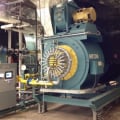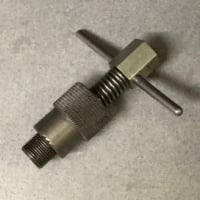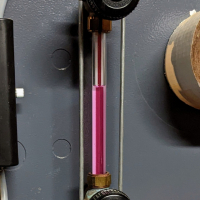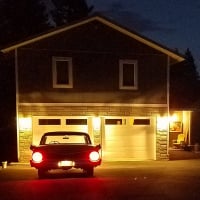Barometric damper for oil burner

The current ones are very worn out and the dampers get stuck sometimes.
Comments
-
Isn't there a fixed flue damper at the rear (or top) of the unit?
If you need one, I like the Field Controls one with the weight on the side, but none of them are really robust.
You should be at positive pressure at the breach, so you vent pipe needs to be sealed.
Manual if you need it:
https://www.weil-mclain.com/sites/default/files/field-file/Weil-McLain_80-Series1_BoilerManual_550141935_1018.pdfThere was an error rendering this rich post.
0 -
@Mike_Sheppard I agree with @STEVEusaPA I like the field controls They have excellent customer service also
'Ray Wohlfarth
Boiler Lessons0 -
Yes the boilers have outlet dampers used for setting firebox pressure.
The customer mentioned to me that in the past they have had incidents where the combustion was off and they would huff and spill smoke and soot into the boiler room from the dampers. The current ones are in bad shape, very worn out. I want to replace them with the proper single acting dampers.
These ones are also Field Controls brand.
I will look into it. Thank you!Never stop learning.0 -
@Mike_Sheppard , be sure to look at the manual posted above before you do anything with those barometrics. The info you need is on page 31.
When a pressure-firing boiler such as the W-M 80 series is vented into a chimney, it is NOT running as a "forced-draft" unit, but as a "balanced-draft" unit. Everything past the breech damper is (or should be) running under negative draft. Among other things, this insures that combustion products do not spill into the boiler room.
Therefore, even though the flue collar is 8-inch, the table says you need to increase the chimney connector (smoke pipe) size to 11-inch and have at least an 11-inch round or 12x16 rectangular chimney flue that is at least 15 feet high.
Since they don't make 11-inch smoke pipe or barometrics, you're looking at 12-inch ones. Barometrics in these sizes are suitable for oil or gas firing- you simply remove a stop to allow double-swing use for gas.
OK, this is gonna cost a bit more, but it'll solve your problems. We do this on every pressure-firing boiler we install that vents into a chimney, and it works every time.
Do these boilers all have their own chimneys, or does more than one boiler fire into the same chimney?All Steamed Up, Inc.
Towson, MD, USA
Steam, Vapor & Hot-Water Heating Specialists
Oil & Gas Burner Service
Consulting1 -
Used to run into this. MA code used to call for a barometric on every boiler....behind the times...new technology.
You can probably get away with taking the barometric's off. Unless you have an abundance of draft you probably don't need them0 -
FYI, you can get stainless steel rigid chimney liner as connector pipe in virtually any diameter you need. Since you need heavier wall thicknesses as diameter increases, ss is a great way to meet this requirement. A 26 ga. ss liner is equal to a 24 ga. galv. vent connector. A side benefit is permanency. A 316L ss rigid pipe will typically carry a lifetime transferrable warranty. Bullet proof.
If your system is running under positive pressure then really and truly you should be using listed pressure vent at least for the connectors until it turns north and goes negative. Need to take measurements to be sure.0 -
I’m just looking at replacing worn out barometric dampers, to my knowledge, nothing is wrong with the venting.
@Steamhead each one has it’s own b vent that goes straight up through the roof about 40 feet in length.
They definitely need dampers. If I hold the dampers closed they have way too much draft.
Nothing wrong with their current setup. The dampers are just worn out on a couple of them. Was just wondering what brand you guys like.Never stop learning.0 -
> @Mike_Sheppard said:
>
> @Steamhead each one has it’s own b vent that goes straight up through the roof about 40 feet in length.
You mean triple wall chimney vent right?1 -
-
@Mike_Sheppard ,
Field, I don't know what else is available. If the stacks are 40' you need barometrics for sure.
Now that you have the burners smoothed out hopefully the barometrics will not be banging and puffing soot0 -
I don’t know why I said b-vent. You are correct.
@EBEBRATT-Ed no more puffing soot. Before I even started on the burners I had to clean all the soot out of the boiler room. So far so good.Never stop learning.0 -
So the L-vents are only 8" diameter all the way up??Mike_Sheppard said:
@Steamhead each one has it’s own b vent that goes straight up through the roof about 40 feet in length.
They definitely need dampers. If I hold the dampers closed they have way too much draft.All Steamed Up, Inc.
Towson, MD, USA
Steam, Vapor & Hot-Water Heating Specialists
Oil & Gas Burner Service
Consulting0 -
@Steamhead they get bigger way up in the ceiling. I can confirm next time I am back. I do know they draft well. Here is a picture of one of the smaller boilers.Never stop learning.0
-
That will be interesting. I think the draft is probably overwhelming those 8-inchers. Remember, when it gets cold the draft will increase well beyond what it is on a 90-degree day, so if the barometrics don't slam all the way open now they most likely will in cold weather. At that point they are no longer regulating the draft, and it will increase considerably. Even on a boiler with a breech damper, this will affect the pressure over the fire- it's just high pressure going to low pressure, and if the low pressure in the L-vent stack goes even lower the over-fire pressure will decrease as well, affecting the fuel-air mix and possibly causing loss of retention at the burner head.
Forced-draft is really intended for a boiler that exhausts into a short stub flue that just goes through an outside wall and ends.All Steamed Up, Inc.
Towson, MD, USA
Steam, Vapor & Hot-Water Heating Specialists
Oil & Gas Burner Service
Consulting0 -
@Steamhead I have the draft set at about -0.02 and the dampers are probably about halfway open. I think you're right, when it gets cold outside they will probably have too much draft even with the barometric fully open.
There are just a lot of issues to fix here. At least they shouldn't soot up as quickly anymore and bang the barometrics open every time they light off.Never stop learning.0 -
Oh, one other thing I forgot to mention. I have never seen this before. These burners have a honeywell 7800 flame safeguard rather than an oil primary control. They are using an infrared flame scanner rather than a cadcell. I'm not sure if they are custom made brackets to mount the scanner on, or if Beckett makes them, but in order for them to see the flame correctly the last company drilled a hole in each of the diffusers. Not sure how that is affecting the combustion.Never stop learning.0
-
I'd like to see a picture of that.Mike_Sheppard said:Oh, one other thing I forgot to mention. I have never seen this before. These burners have a honeywell 7800 flame safeguard rather than an oil primary control. They are using an infrared flame scanner rather than a cadcell. I'm not sure if they are custom made brackets to mount the scanner on, or if Beckett makes them, but in order for them to see the flame correctly the last company drilled a hole in each of the diffusers. Not sure how that is affecting the combustion.
Ed's favorite, 2 pipe. Although by code you are not allowed to have a shut off on the return line.There was an error rendering this rich post.
0 -
@STEVEusaPA agreed on the return line shut off. I’ve run many calls where the customer switched to oil and forgot to open the return valve. Had one where the seal blew and the burner caught on fire. It was a larger Gordon Piatt burner. Boiler cleaners turned the switch on and walked away but left the valve closed.
Also had a 700 hp cleaver brooks oil filter blow out next to me when the engineer turned the transfer pumps on and left the return valve closed. I took a fuel oil bath. Completely soaked from head to toe.
Here is a picture of the hole drilled in the diffuser. Scanner is directly behind it. I don’t think I took a good picture of the scanner.Never stop learning.0 -
I'd check w/Beckett regarding the peep hole in the head- they may have a service bulletin on that.All Steamed Up, Inc.
Towson, MD, USA
Steam, Vapor & Hot-Water Heating Specialists
Oil & Gas Burner Service
Consulting0 -
Usually with the return pipe blocked, seals blow out in seconds.
It's the main reason why I hate 2 pipe. Oil could dump on the floor all night and the burner could still run.
Explain to them it's against code and needs to be removed for safety to avoid damage, and risk a major spill. If you can't, at least remove the handles and try to permanently tag them to remain open. You can still have the same issue if any of the return line gets blocked.
Transfer pumps shouldn't be putting any pressure on the filter, or fuel pump, or pressuring the oil line to the fuel pump as even with an OSV, you could still blow out the pump seals.
Transfer should only be filling a day tank (I hope).
The clean head looks good. I don't see a way around not having the hole, even if you switch to a cad cell.
Looks like you're doing a fantastic job and hopefully no one will touch them after you have them humming nicely.There was an error rendering this rich post.
0 -
Yep I've seen it happen. Luckily it wasn't my fault. I've blown one filter gasket out from a transfer pump. I'll admit to that one. I couldn't find a return valve anywhere. There was a ball valve on the return behind a storage tank that I physically couldn't even get to. They installed the tank in front of it years ago and never ran oil until then.STEVEusaPA said:Usually with the return pipe blocked, seals blow out in seconds.
It's the main reason why I hate 2 pipe. Oil could dump on the floor all night and the burner could still run.
Explain to them it's against code and needs to be removed for safety to avoid damage, and risk a major spill. If you can't, at least remove the handles and try to permanently tag them to remain open. You can still have the same issue if any of the return line gets blocked.
Transfer pumps shouldn't be putting any pressure on the filter, or fuel pump, or pressuring the oil line to the fuel pump as even with an OSV, you could still blow out the pump seals.
Transfer should only be filling a day tank (I hope).
The clean head looks good. I don't see a way around not having the hole, even if you switch to a cad cell.
Looks like you're doing a fantastic job and hopefully no one will touch them after you have them humming nicely.
Had a medical research facility call me on new years eve. Drove two hours there. Two large Riello burners on firetube boilers. Both seals were blown and dumping oil on the floor. I asked if they both blew at the same time. He said no, the first on blew about a month ago and they ignored it. He was upset to find out I didn't carry commercial Riello oil pumps on my truck... Wouldn't have fixed it anyways, the return line to the tank was clogged. They ended up abandoning the underground tank and installed new ones.
Their transfer pump is currently maintaining 2 psi on the loop. I am actually not familiar with these Suntec pumps, I am used to the webster pumps on larger burners being able to handle 5 psi on the suction side. They currently do not have day tanks. The transfer pump maintains pressure on a loop and the burner pumps draw off of it.Never stop learning.0 -
If you need a valve on the return (in order to change a pump etc.) just a good swing check will work.
That hole in the diffuser looks factory to me. Lead sulphide (infrared) needs to see flickering light won't work with reflected light or a light bulb like a cad cell will. Much safer and more sensitive (and more trouble LOL) than a cad cell.
infrared works on oil or gas as does uv although infared is usually a better on oil and uv is better on gas, most use uv now don't see that much infrared anymore at least around here
Depending on the code requirements (did I read Military somewhere) that explains no cad cell
I fact with infrared those could be "self checking scanners and amplifiers" ....you might take a look.used to be required in MA. on oil over 20gph firing rate. I think the FEDS require self checking.
As far as I know you can't use UV for self checking unless you use the big scanner with a shutter in it.........wont fit in the blast tube0 -
Checks are not allowed on the return by code either...right?
There was an error rendering this rich post.
0 -
I’m not sure on the code but I always see a check valve on the return.Never stop learning.0
-
I see no problem with checks, especially when the tank level is higher than the pump. How else do you change the pump????
Every good two pipe system has checks0 -
NFPA 31
8.7.4 The pressure at the fuel supply inlet to an appliance shall not exceed a gauge pressure of 3 psi unless the appliance is approved for a higher inlet pressure.
9.2.13 Means shall be provided to limit the oil pressure at the appliance inlet to a maximum gauge pressure of 3 psi.
8.7.7 Fuel Return Piping.
A return line from a burner or a pump back to a supply tank shall have no valves or obstruction except for a hard-seat or ball valve that shall be left in the open position, with the handle removed, and shall enter the top of the same tank.There was an error rendering this rich post.
0 -
Interesting. 2015 International mechanical code, 1305.4, says, "valves shall not be installed on return piping."Never stop learning.0
-
Yeah that 8.7.7 is the first time I ever heard of it, everyone else says no.
There was an error rendering this rich post.
0 -
I've never not seen a return line without a check valve or ball valve. Don't see the ball valve too often but every return line I've seen that doesn't have a ball valve has had a check valve.Never stop learning.0
-
Categories
- All Categories
- 85.7K THE MAIN WALL
- 3K A-C, Heat Pumps & Refrigeration
- 51 Biomass
- 423 Carbon Monoxide Awareness
- 71 Chimneys & Flues
- 1.9K Domestic Hot Water
- 5.2K Gas Heating
- 92 Geothermal
- 149 Indoor-Air Quality
- 3.2K Oil Heating
- 59 Pipe Deterioration
- 850 Plumbing
- 5.8K Radiant Heating
- 371 Solar
- 14.5K Strictly Steam
- 3.2K Thermostats and Controls
- 51 Water Quality
- 38 Industry Classes
- 55 Job Opportunities
- 18 Recall Announcements






